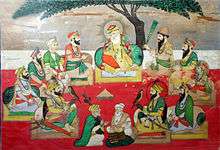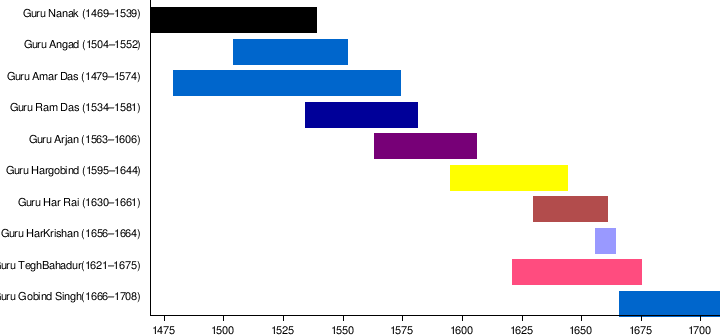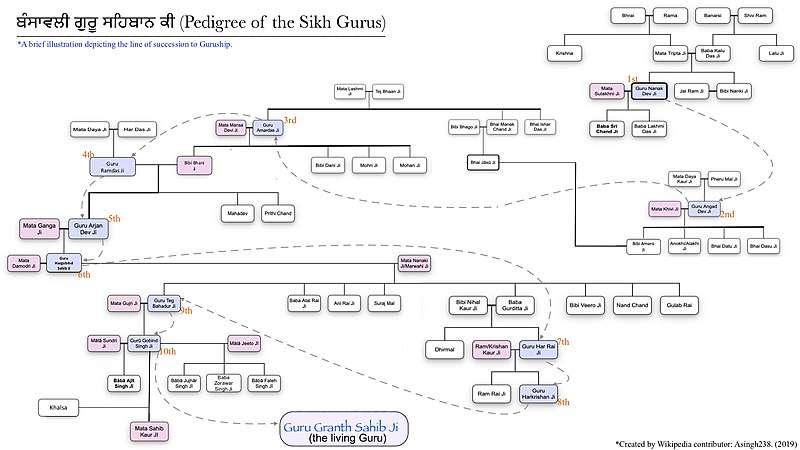Sikh gurus
The Sikh Gurus (Punjabi: ਸਿੱਖ ਗੁਰੂ) are the spiritual masters of Sikhism, who established this religion over the course of about two and a half centuries, beginning in 1469.[2] The year 1469 marks the birth of Guru Nanak, the founder of Sikhism. He was succeeded by nine other gurus until, in 1708, the Guruship was finally passed on by the tenth guru to the holy Sikh scripture, Guru Granth Sahib, which is now considered the living Guru by the followers of the Sikh faith.[3] All ten Gurus hailed from the Khatri.[4]

Guru: Etymology and Definition
Guru (/ˈɡuːruː/, UK also /ˈɡʊruː, ˈɡʊər-/; Sanskrit: गुरु, Punjabi: ਗੁਰੂ, IAST: guru) is a Sanskrit term for a "teacher, guide, expert, or master" of certain knowledge or field.[5] Bhai Vir Singh, in his dictionary of Guru Granth Sahib describes the term Guru as a combination of two separate units: "Gu;(ਗੁ)" meaning darkness and "Rū;(ਰੂ)" which means light.[6] Hence, Guru is who brings light into darkness or in other words, the one who enlightens.
Bhai Vir Singh's definition provides further insight about Sikhism itself and explains why Guru Granth Sahib is considered the living Guru. The word Sikh is derived from the Sanskrit term shishya[7](Punjabi: ਸਿੱਖ) which means a disciple or a student. Thus, Sikhs have a student-teacher relationship with their Gurus since their teachings, written in Guru Granth Sahib, serve as a guide for them.
The Gurus
| # | Name | Date of birth | Guruship on | Date of death | Father | Mother |
|---|---|---|---|---|---|---|
| 1 | Guru Nanak Dev Ji | 14 April 1469[note 1] | Since birth | 22 September 1539 (aged 70) | Mehta Kalyandas | Mata Tripta |
| 2 | Guru Angad Dev Ji | 31 March 1504 | 7 September 1539 | 29 March 1552 (aged 47) | Baba Pheru | Mata Ramo |
| 3 | Guru Amardas Ji | 5 May 1479 | 26 March 1552 | 1 September 1574 (aged 95) | Tej Bhan Bhalla | Mata Bakht |
| 4 | Guru Ramdas Ji | 24 September 1534 | 1 September 1574 | 1 September 1581 (aged 46) | Baba Hari Das | Mata Daya Vati |
| 5 | Guru Arjan Dev Ji | 15 April 1563 | 1 September 1581 | 30 May 1606 (aged 43) | Guru Ramdas Ji | Mata Bhani |
| 6 | Guru Hargobind Ji | 19 June 1595 | 25 May 1606 | 28 February 1644 (aged 48) | Guru Arjan Dev Ji | Mata Ganga |
| 7 | Guru Harrai Ji | 16 January 1630 | 3 March 1644 | 6 October 1661 (aged 31) | Baba Gurditta | Mata Nihal |
| 8 | Guru Harkrishan Ji | 7 July 1656 | 6 October 1661 | 30 March 1664 (aged 7) | Guru Harrai Ji | Mata Krishan |
| 9 | Guru Teg Bahadur Ji | 1 April 1621 | 20 March 1664 | 11 November 1675 (aged 54) | Guru Hargobind Ji | Mata Nanki |
| 10 | Guru Gobind Singh Ji | 22 December 1666 | 11 November 1675 | 7 October 1708 (aged 41) | Guru Teg Bahadur Ji | Mata Gujri |
Timeline of Sikh Gurus

Pedigree of Sikh Gurus[note 2]

See also
- History of Sikhism
- Khalsa Panth
References
- The Sikhs. E.J. Brill. p. 38. ISBN 9004095543.
- Sen, Sailendra (2013). A Textbook of Medieval Indian History. Primus Books. pp. 186–187. ISBN 978-9-38060-734-4.
- The Sikhs : faith, philosophy & folk. Lustre Press. ISBN 9788174360373.
- Don (2015). South Asian Politics and Religion. Princeton University Press. p. 155.
- Stefan Pertz (2013), The Guru in Me - Critical Perspectives on Management, GRIN Verlag, ISBN 978-3638749251, pages 2-3
- Singh, Veer (1964). Sri Guru Granth Kosh. p. 122.
- World religions : from ancient history to the present. ISBN 978-0-87196-129-7.
Notes
- officially observed on Kartik pūranmāshī (October–November). See Main article: Guru Nanak Dev Ji
- Listed names and relations might vary from source to source since different aspects of Sikh history have been written by many different individuals over the course of past six centuries.